Vive Cosmos - review of the new VR set from HTC
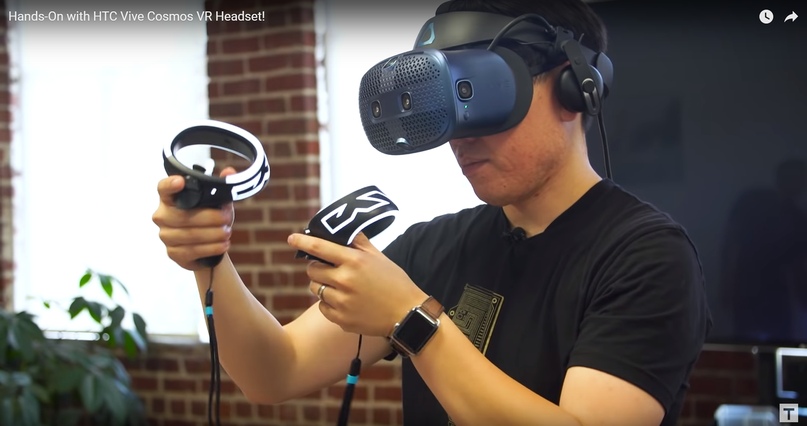
HTC has a new flagship in the line of VR sets for the consumer sector - HTC Vive Cosmos. Therefore, I translated and digested for you preliminary reviews of this device from guys who have proven themselves in the field of virtual reality, so that it would be easier for you to make a decision on whether to pre-order this gadget now.
First of all, you need to understand that this device is designed to replace the HTC Vive model. Versions of Pro and Pro Eye will remain on the market for business and professionals.
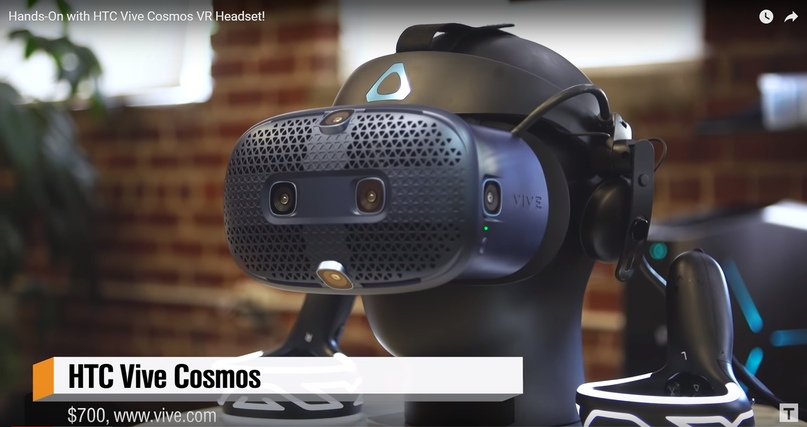
So, some important details: deliveries will begin on October 3 at a price of $ 700 (or € 799 in Europe), and this device (for now) is designed for desktops - that is, it is not a competitor to the Oculus Quest helmet - there is no built-in computer or battery.
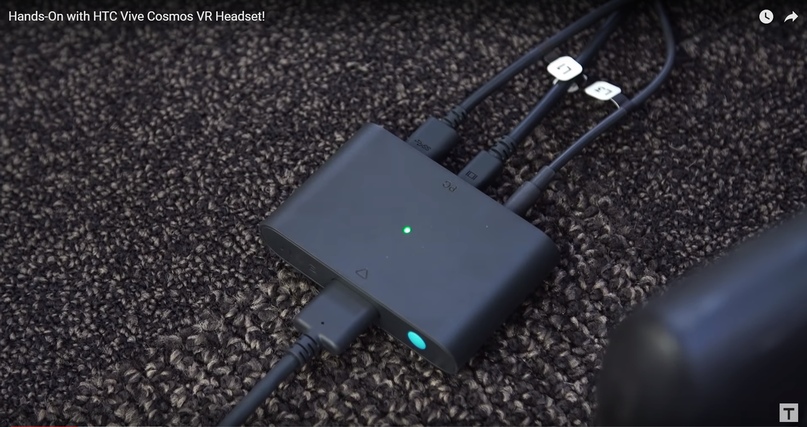
Thus, Vive Cosmos stands in line with the old wives, Valve Index, WMR helmets and Oculus Rift S. And now, just like in the latter, we are waiting for positioning using the cameras built into the helmet. Thus, it is no longer necessary to use external base stations, as it, for example, works in the case of Vive.
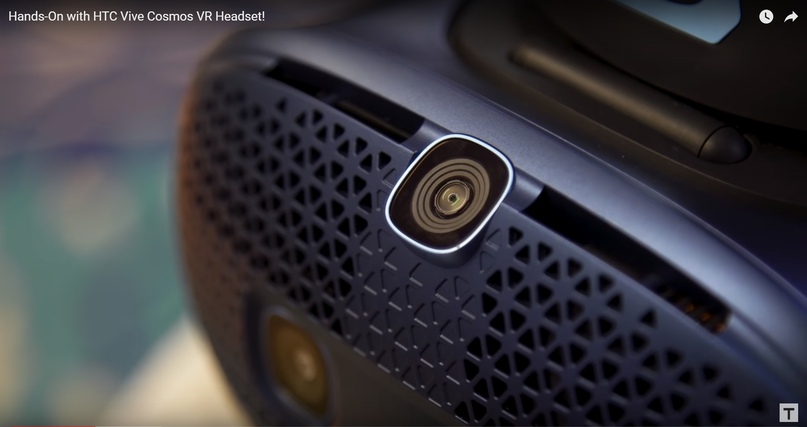
There are 6 cameras for tracking on the helmet: two in front, one on top, one on the bottom, and one on each side. These cameras allow the helmet to navigate in the space of your playing area, as well as track the position of the controllers. It is still unknown how tracking behaves in low light conditions and direct sunlight, but most likely not very.
The displays in the helmet are different from what we are used to seeing on HTC. Now they are 2880x1700 LCD panels (compared to 2880x1600 in the Valve Index, Vive Pro or Oculus Quest) with RGB subpixels.

The field of view remained at the level with the rest of the helmets of the company and is 110 degrees according to the developers. But in this way we get a fairly high pixel density per degree of viewing angle. Yes, individual pixels or their vertical rows can still be seen by freezing in place and looking at the picture, but in terms of clarity of the picture, a big step forward is taken compared to previous HTC helmets. The displays operate at a frequency of 90 Hz, and the lenses "are 40% better than the lenses on HTC helmets of the previous generation" according to the developers themselves. Testers felt the difference and report that the sweetspot high-definition area has expanded, although it has become more difficult to “find” it — properly fit the helmet.

A very important distinguishing feature of the helmet design is the flip-up design, which allows you to rotate the front panel to see the real world without having to remove the entire helmet. The introduction of such a feature in the design, however, deprived us of the opportunity to move the lenses closer to the eyes (or move away from the glasses), as can be done in previous wives, index or rift S.
In ergonomic terms, the mount changed to the Halo style, which we can see on the PSVR, Rift S or WMR helmets. This method of attachment relieves pressure from the face and transfers it to the frontal part of the head and slightly simplifies the process of “equipment”.

In terms of audio, we expect built-in headphones that we could see in the Deluxe Audio Strap for HTC Vive helmets. They provide excellent volume and isolation from external sounds.
The front cameras, in addition to tracking, provide the opportunity, if desired, to see a picture of the real world in stereo and color. This, for example, is very convenient for beginners who, when leaving the gaming area, will immediately see where they are going to crash. The resolution is not particularly higher than on the Rift S or Valve Index. You can display images from cameras at any time by double-clicking the system button on the controller.
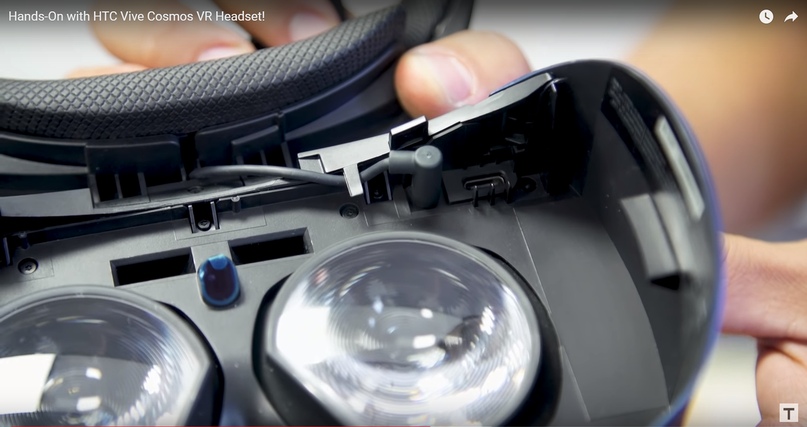
An interesting feature of the Vive Cosmos set is its modular design and openness for future upgrades. Under the face mask, you can find the USB-C port and audio jack. Headphones are disconnected if desired, making it possible to replace them with your own version.
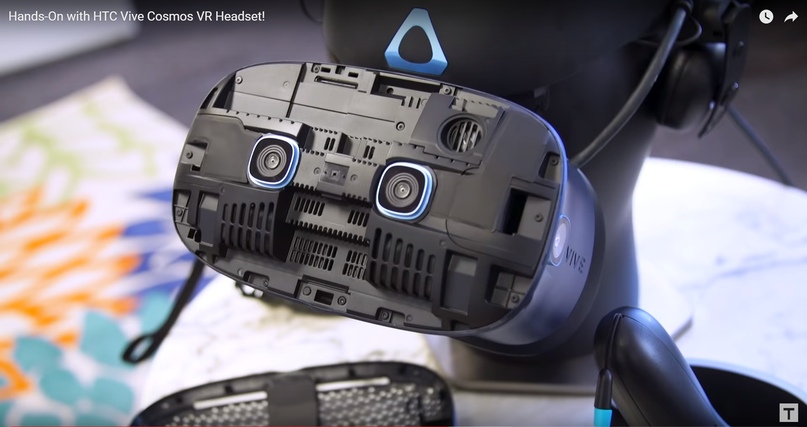
The front panel of the helmet is also removable along with two cameras. This is done to enable future use of a removable faceplate with sensors for tracking in the Valve Lighthouse environment, which will allow, for example, to use this helmet together with controllers from Valve Index or Vive trackers.

Another upgrade that can be done on Vive Cosmos is getting rid of wires using the Vive Wireless Adapter. It is already available for Vive and Vive Pro, and to work with Vive Cosmos you will need to purchase a special adapter.
Let's talk a little about controllers. They are very similar to the Oculus Touch for the Quest and Rift S helmets. However, there are some serious differences. The first is weight. Each controller is powered by TWO AA batteries, which, according to reports, will give you only about two hours of controller operation.

Tracking on reviews is pretty good, but doesn't work behind your head or too close in front of you.

Problems with tracking are very similar to those that we saw at the start of sales of Rift S and Quest (for example, loss of tracking when one joystick blocks another). However, for the Oculus sets, these jambs were eliminated with the help of software, so the situation with tracking controllers on HTC will also be resolved in the future.

Instead of one trigger, there are now two of them on the index finger (a “bumper” has been added). So far, no game supports these buttons, but they can be reassigned to any other (which can be useful, for example, to simulate a gamepad). The side button is not analog, like on Oculus Touch, but discrete and “clicked”, like on Vive.
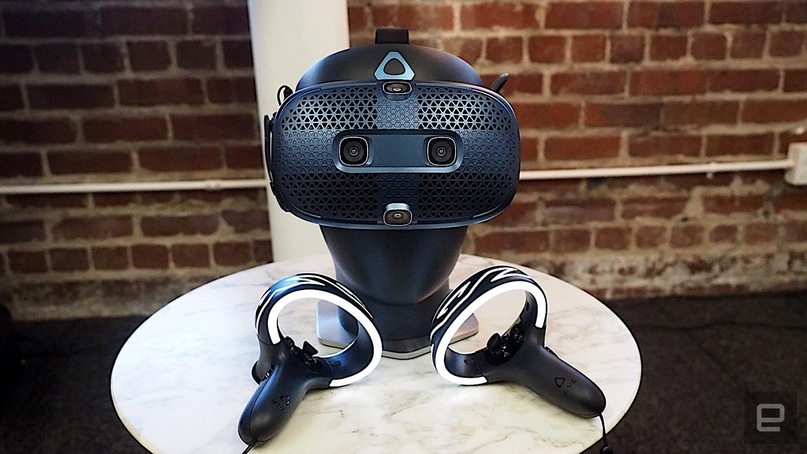
As a result, from the moment the specifications were published, the set did not present anything unexpected, except for the lack of Eye Relief (the ability to move lenses closer or further away from the face) and a fiasco with batteries. The kit costs more than the Oculus Rift S (its most similar competitor), but it gives a slightly better picture, the ability to physically adjust the IPD interpupillary distance, and compatibility with the Valve Lighthouse ecosystem. And for those who pre-order, an annual subscription to Viveport Infinity will be available - a library of ~ 700 games for virtual reality, which is important for those who do not use the Steam platform and pay from 10 to 30 dollars per game. To me, this helmet seems very specific for now, but maybe it will find its niche in Russia, where HTC has a more or less “official” representation and helmets from this company can be purchased in almost any electronics store.
All Articles